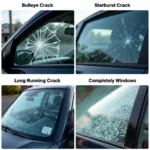When it comes to car aesthetics and comfort, tinted windows are a popular choice. They offer privacy, reduce glare, and protect your car’s interior from harmful UV rays. However, over time, window tint can bubble, peel, or fade, ruining the look of your car and potentially obstructing your view. If you’re dealing with damaged window tint, don’t fret! This guide will walk you through the steps on how to repair tint on car windows and restore them to their former glory.
Understanding Window Tint Damage
Before diving into the repair process, it’s important to identify the type of damage your window tint has sustained. Common issues include:
- Bubbling: Air pockets trapped between the tint and the window, creating unsightly bumps.
- Peeling: Edges of the tint lifting or separating from the window surface.
- Fading: Loss of color intensity, usually due to prolonged sun exposure.
- Scratching: Visible marks or abrasions on the tint surface.
Assessing the Reparability of Your Window Tint
While minor bubbling and peeling can often be fixed, severe damage might require a complete tint replacement. If the tint is extensively faded, scratched, or the adhesive has deteriorated significantly, a replacement is the more practical solution.
DIY Repair for Minor Tint Damage
For minor bubbling or peeling, you can attempt a DIY repair using readily available materials:
Materials You’ll Need:
- A spray bottle
- Distilled water
- A few drops of mild dish soap
- A squeegee or credit card wrapped in a soft cloth
- A hairdryer or heat gun (optional)
Step-by-Step Repair Process:
- Clean the Affected Area: Thoroughly clean the window surface around the damaged tint using the soapy water solution and a soft cloth.
- Apply Heat (Optional): If the damage involves peeling edges, carefully apply heat using a hairdryer or heat gun to soften the adhesive. Maintain a safe distance to avoid burning the tint or the window.
- Spray and Squeegee: Mist the damaged area with the soapy water solution. Using the squeegee or credit card wrapped in cloth, gently push out any air bubbles or press down the peeled edges, working from the center outward.
- Dry and Inspect: Allow the tint to dry thoroughly. Use the hairdryer on a low setting to speed up the drying process if needed. Inspect the repaired area for any remaining bubbles or imperfections.
When to Seek Professional Help
If the DIY repair doesn’t yield satisfactory results, or if the damage is extensive, it’s best to consult a professional window tinting service. They have the expertise and specialized tools to handle complex repairs or perform a complete tint replacement.
Preventing Future Window Tint Damage
- Avoid Harsh Chemicals: Use ammonia-free cleaners on your tinted windows, as ammonia can damage the tint film.
- Park in the Shade: Whenever possible, park your car in a shaded area to minimize prolonged sun exposure, which can cause fading.
- Use Window Shades: Employ window shades or sunscreens to further protect your tinted windows from direct sunlight.
- Roll Down Windows Carefully: Be cautious when rolling down your windows, especially during the initial days after installation or repair, to avoid scratching or peeling the tint.
Conclusion
Knowing how to repair tint on car windows can save you time and money in dealing with minor damage. However, it’s essential to assess the severity of the issue and determine if a DIY approach is suitable. For significant damage or if you’re unsure about the repair process, don’t hesitate to seek professional assistance to restore your car windows to their optimal condition.

